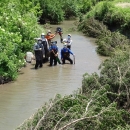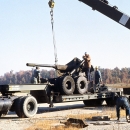What We Do
Although the ultimate objectives and mission of the military services and the Service are different, the outcomes of the collaborative conservation partnerships are the same.
Under interagency agreements, the Service provides expertise to assist the U.S. Air Force and the U.S. Army in the development and application of sound ecological principles, scientific knowledge, and on-the-ground experience conserving and protecting the Nation’s fish, wildlife, and their habitats. The Service offers the military guidance for the appropriate conservation, development, and management of the natural resources on their installations while supporting military readiness. These collaborative partnerships have demonstrated gains for our Nation’s natural resources, provide invaluable public outdoor recreational opportunities, and continue to provide conservation advantages into the future. These are synergistic relationships that benefit from working together and leveraging agency resources and expertise.
The Department of Defense manages approximately 27 million acres of land on 338 military installations that is largely protected from development. These lands support the preservation of ecologically important native habitats such as old-growth forests, tall-grass prairies, coastal beaches, and wetlands making military installations a haven for fish, wildlife, and plants, including rare and unique species.
The Sikes Act requires the U.S. Fish and Wildlife Service, state fish and wildlife agencies, and military installations across the nation and in the Pacific to work collaboratively to conserve natural resources. The Sikes Act ensures the protection and enhancement of ecosystems, sustain military operations, and meet mission success. Working under the Sikes Act, the Service offers the military guidance and support for the conservation and management of fish and wildlife resources on military installations while supporting military readiness.
Our Services
Most military installations develop and implement a comprehensive plan for natural resource conservation and management (e.g., fish and wildlife, forestry, land management, outdoor recreation) on the installation. The conservation plans, known as an Integrated Natural Resource Management Plans, focus on ecosystem-based management with a goal of managing the natural resources to meet stewardship requirements while supporting, and even enhancing, military operations.
Military installations prepare their Integrated Natural Resource Management Plans in cooperation with the U.S. Fish and Wildlife Service and state fish and wildlife agencies, ensuring appropriate consideration of fish, wildlife, and their habitat needs. These plans also include components that provide a variety of recreational opportunities including hunting, fishing, camping, and hiking. This collaborative conservation between the Service, states, and the military installations to develop and implement these Integrated Natural Resource Management Plans is the cornerstone of the Sikes Act.
Our Projects and Research
Readiness and Environmental Protection Integration
The Department of Defense (DoD)’s REPI program is a key tool for combating encroachment that can limit or restrict military training, testing, and operations. The Readiness and Environmental Protection Integration program protects these military missions by helping remove or avoid land-use conflicts near installations and addressing regulatory restrictions that inhibit military activities. REPI is administered by the Office of the Secretary of Defense (OSD). A key component of REPI is the use of buffer partnerships among the military services, private conservation groups, and state and local governments, authorized by Congress at 10 U.S.C. § 2684a.







